
Pissoirs
Pissoirs: Extremely Public Urinals
Pissoirs have a long history.
This isn't about urinals in general,
but public ones with little to no privacy.
Municipal public urinals aren't new.
The Romans imposed a tax on urine
collected at public facilities.
That Roman urine tax led to a
current-day alternative name, vespasiennes.
During World War II,
the French Resistance used pissoirs
found throughout Paris as rendezvous points.
The résistants exchanged information on
German movements during what seemed to be normal and
necessary diversions from the daily routine.
Pissoirs remain
along the streets of Paris.
Yes, there are the private cubicles of the
automated Sanisettes,
introduced in 1981 by then-Mayor Jacques Chirac.
But simple open-air pissoirs still exist in Paris.
You also find pissoirs throughout France,
and in other countries.
Below is a pissoir in Avranches,
near the coast in western Normandy, near Brittany.
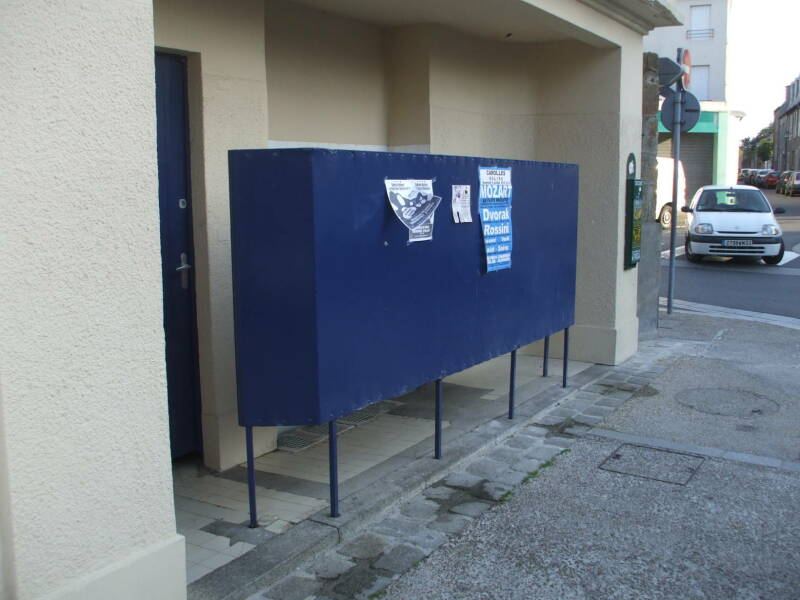
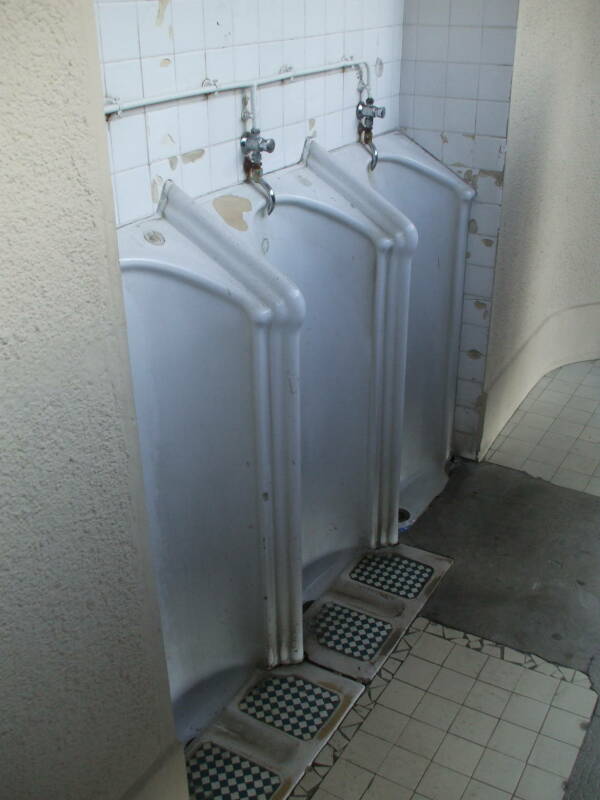
Roman Pissoirs and the Urine Tax
The Romans built public latrines across their empire. But these were typically enclosed spaces, like this large facility at the Senate in Rome.
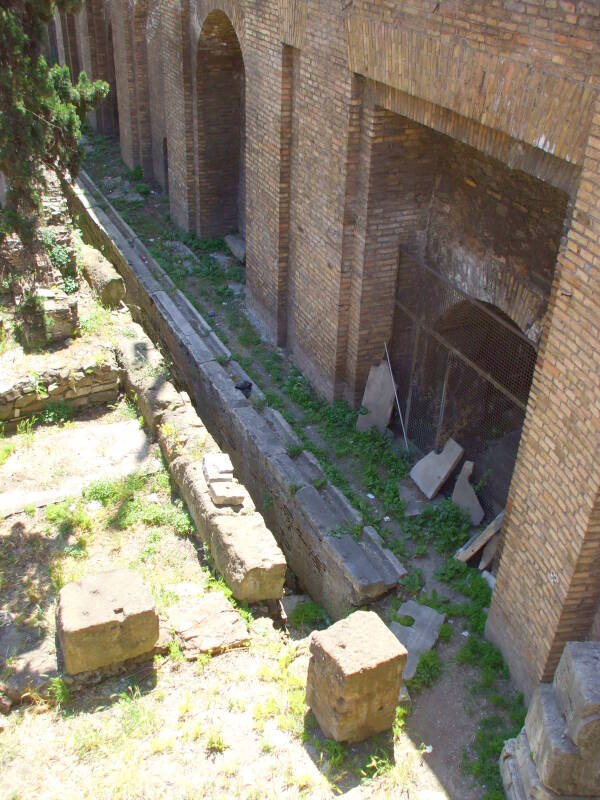
Latrines at the Roman Senate in Rome
These large multi-person facilities provided some privacy, as they banned non-group-members. Access to the above latrine was limited to Senate members. The below, at Vercovicium fort along Hadrian's Wall in Britain, was a military facility.
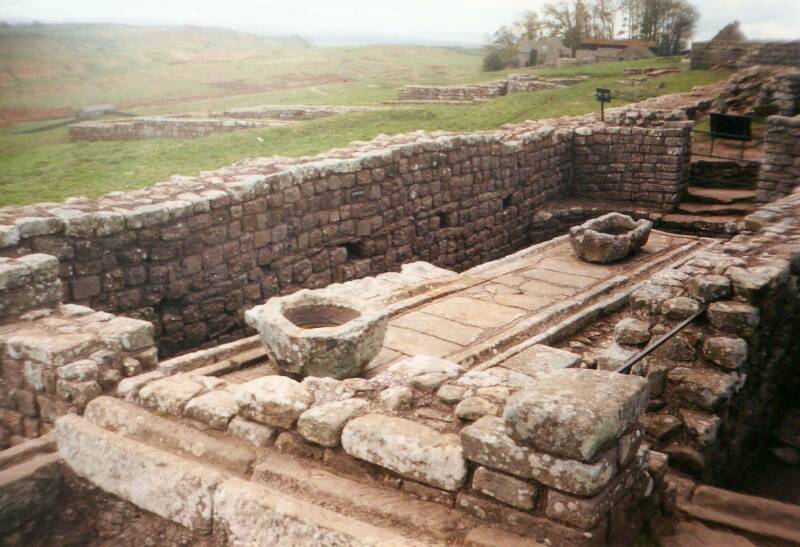
Roman military latrines at Vercovicium along Hadrian's Wall.
The Greek city of Ephesus became a subject of the Roman Republic in 129 BCE, became self-governing, then came back under Roman rule in 86 BCE.
Even truly public latrines, like the below at the Roman administered Greek city of Ephesus, were enclosed. Other people within the facility could certainly see you, they might be sitting right next to you. However, you were out of sight of people walking down the street.
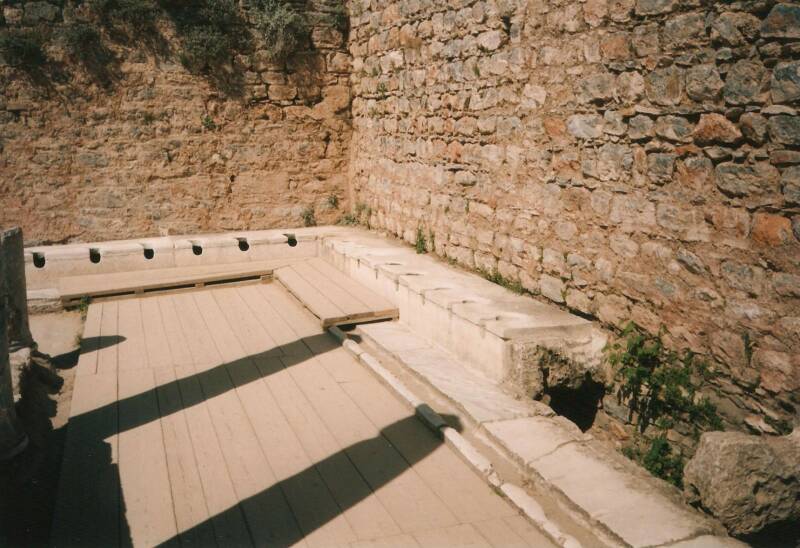
Roman era toilets at the Roman-administered Greek city of Ephesus.
Like Ephesus, Corinth was of course culturally Greek. It had been rebuilt in 44 BCE as a Roman colony and flourished as the administrative capital of the Roman province of Achaea.
The same holds for this public latrine at Corinth, with the mountaintop Akrokorinthos dedicated to Aphrodite in the background. The area has frequent earthquakes, the structure is partially destroyed. Two thousand years ago, this was an enclosed facility.
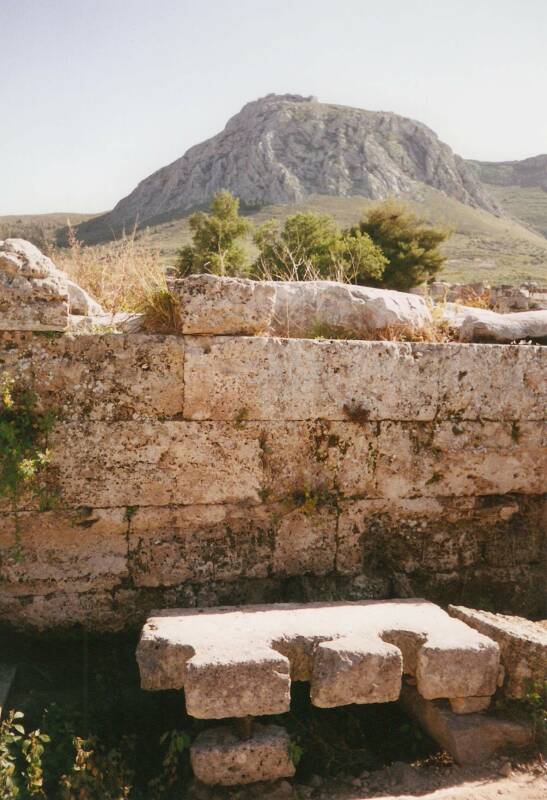
Roman era toilets at the Roman-administered Greek city of Corinth.

Ammonium: NH4+
The Romans found that you could set urine aside to age into a stronger form. The high ammonium or NH4+ content of aged urine made it useful for cleaning tasks, including laundry and processing wool. Romans used it for fulling wool. This is the process of cleaning or scouring to remove oils and dirt, followed by milling or thickening.
Urine contains ammonium salts, which are components of modern soaps. Read your shampoo bottle — a handy bottle of shampoo lists ammonium lauryl sulfate, ammonium laureth sulfate, and ammonium chloride.
A wool fulling operation had to purchase the wool itself from shepherds in the surrounding countryside. But the urine needed for processing might be obtained quite cheaply or even for free. Below is a wool fulling facility in Pompeii.

Wool fulling facility in Pompeii.
The Roman Emperor Nero instituted the vectigal urinæ, a tax on the urine industry. It was discontinued, but then Nero's successor, Titus Flavius Vespasianus, re-instated the urine tax.
Vespasian imposed the tax on the urine collected from the public urinals along Rome's Cloaca Maxima, the capital city's Great Sewer. Urine purchasers paid the tax.
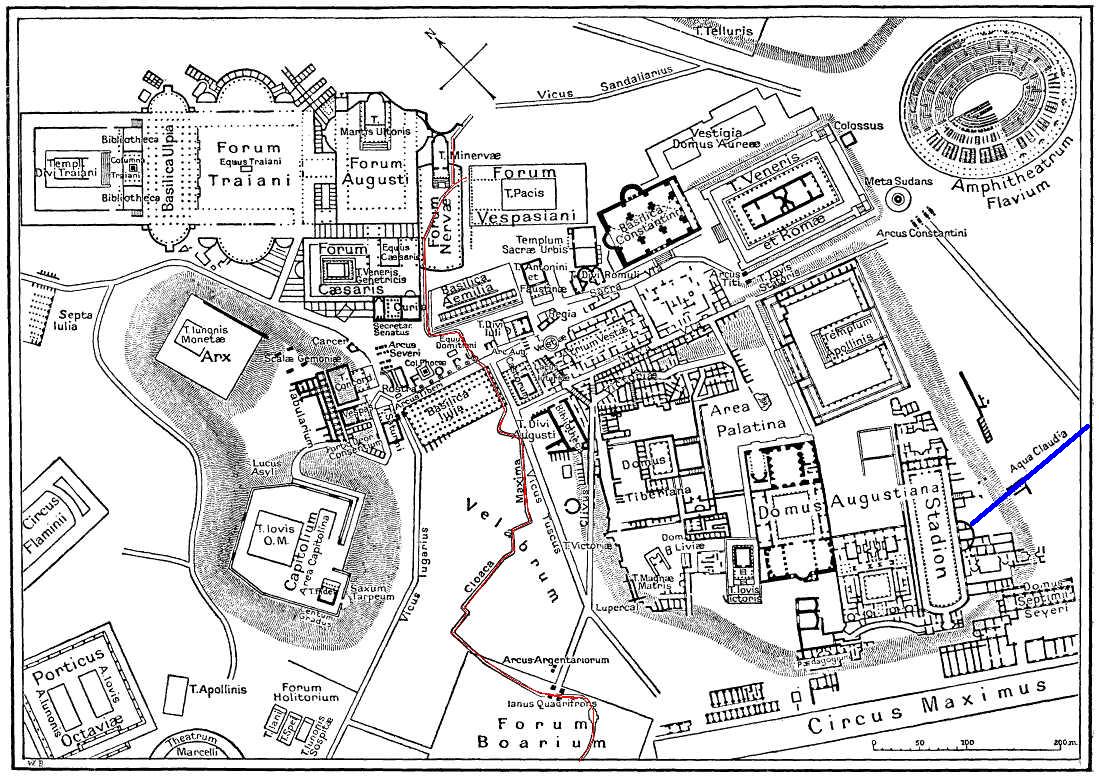
Map of central Imperial Rome showing the Cloaca Maxima running under the Forum.
Vespasian is credited with the Latin saying Pecunia non olet meaning "Money doesn't smell." It's said to have been his reply to his son's complaint about the unpleasant nature of the urine tax.
Vespasian's name is still connected to public urinals in some countries speaking Romance languages:
| France: | vespasiennes |
| Italy: | vespasiani |
| Romania: | vespsiene |
Meanwhile, Nero had an opulent private toilet at his home of Villa Poppaea near Pompeii.
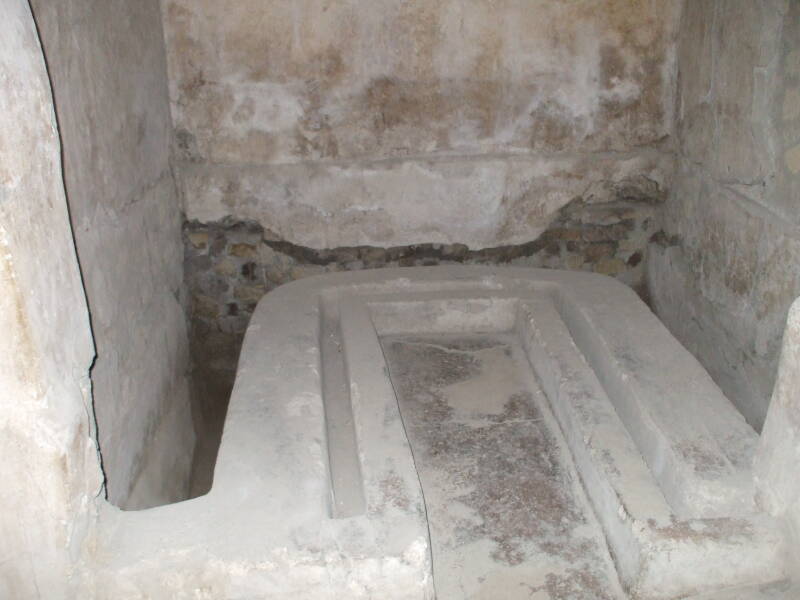
Roman Emperor Nero's toilet at his Villa Poppaea near Pompeii.
Land was the Old English word for urine in general. That evolved into lant, a word that was used into the 19th century in English to refer to aged urine, which continued to be used as an ammonium-rich cleaning fluid.
Pissoirs in Modern Times
Toilet
History
As described in the history of public toilets, sanitation in Europe collapsed along with the Roman Empire. European streets were open sewers, public health suffered.
The streets of Paris were plagued with public urination. The whole city stank of stale urine. The population was rapidly expanding in the early 1800s, soon to pass one million in the 1840s, and so the urine problem was worsening.
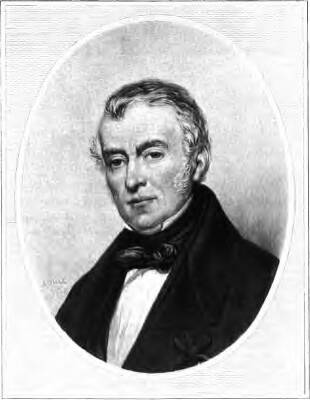
Claude-Philibert Barthelot de Rambuteau, the man who first installed pissoirs in Paris.
A cholera epidemic struck the city in 1832, killing 18,000 people. Cholera is spread by fecal contamination of water or food as later shown by John Snow in London. It was clear that Paris needed some serious sanitation upgrades.
Claude-Philibert de Rambuteau was Préfet de la Seine and thus effectively Mayor of Paris. In 1839 he introduced the first public urinals in Paris.
Public urinals are known in French as pissoirs, or more bluntly as pissotières, from the onomatopoetic term pisse, like the English piss and the Russian писать. Hopefully no one is terribly offended, but a pissoir is a pissoir. And piss was the standard English word at least through the 1600s, when it was used in the King James translation of the Bible. Urine and urinate were medical terms.
Syllabic stress is not shown in Russian, outside children's books, but sometimes it would help. The verb писать is the classic example. Stressed on the second syllable, писатель or piSAtel' means "writer". However, stressed on the first syllable, писатель or PIsatel' means "pisser". We should praise Chekov for his literary talents, not his urinary ones.
Rambuteau famously advocated "De l'eau, de l'air, de l'ombre", or "Water, air, and shade". He worked to improve the water supply, to enlarge the Paris sewer system, and to install gas lighting. The city had just 69 gas lamps when he came into office, and 8,600 when he left. He oversaw the completion of the Arc de Triomphe and the Church of the Madelaine, and the start of the construction of the Avenue des Champes-Élysées.
The urinals Rambuteau started installing in 1839 were simple single-user masonry tubes with an entrance cut into the street side, and a cornice and ball above. Here is a classic masonry tube model.
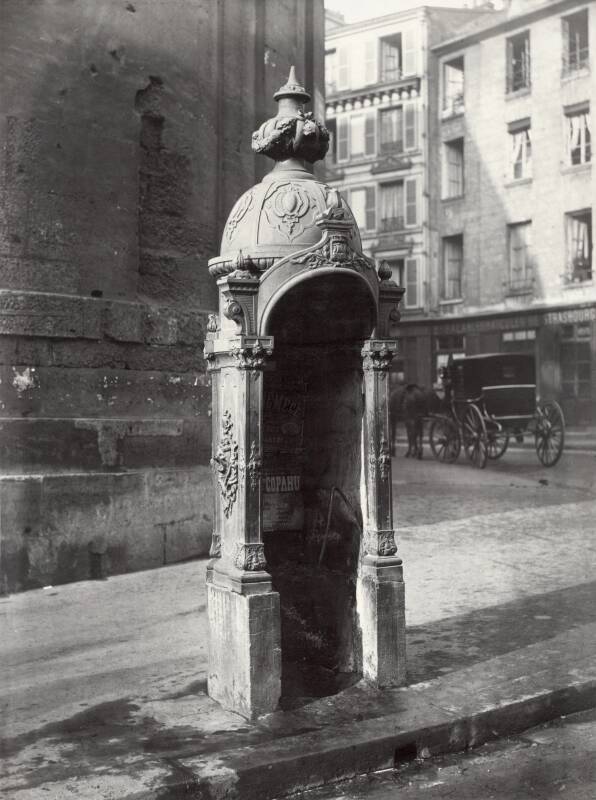
Photograph taken by Charles Marville around 1865, now in the public domain, from Wikipedia.
Later models added panels around the cylinder to provide privacy for the user, and a surface for the city to sell advertising space. Within four years, by 1843, the city had over 400 of these.
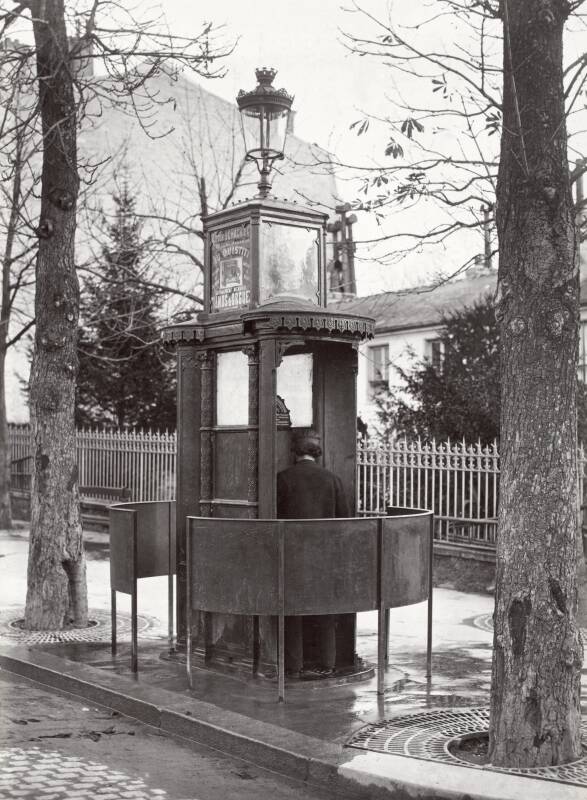
Photograph taken by Charles Marville around 1865, now in the public domain, from Wikipedia
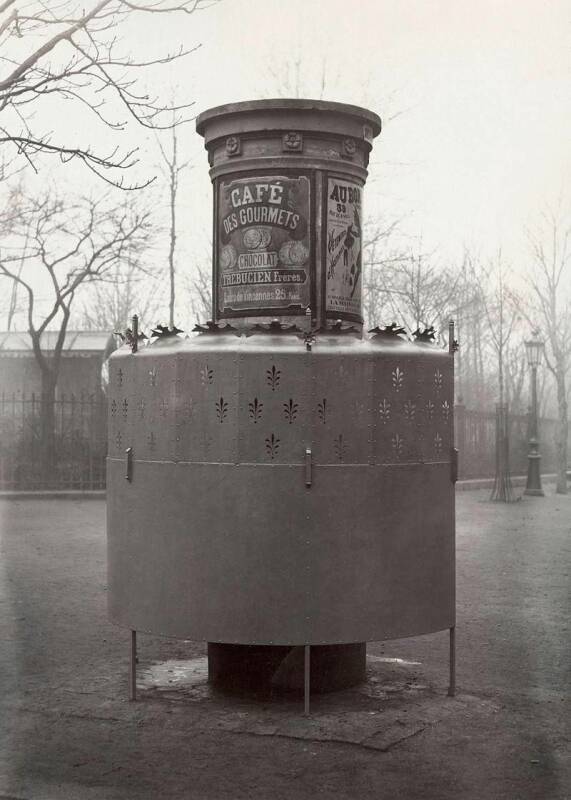
Photograph taken by Charles Marville around 1865, now in the public domain, from Wikipedia.
Parisians called the new public conveniences colonnes Rambuteaux and simply rambuteaux, which annoyed their developer, Monsieur Rambuteau.
The story is that he came up with the alternative term colonne vespasienne, referencing the urine-taxing Roman Emperor. To this day, vespasienne is the mock-sophisticated term for a pissoir.
Rambuteau's successor Baron Haussmann continued transforming mid-19th century Paris, demolishing buildings along narrow streets and building wide avenues.
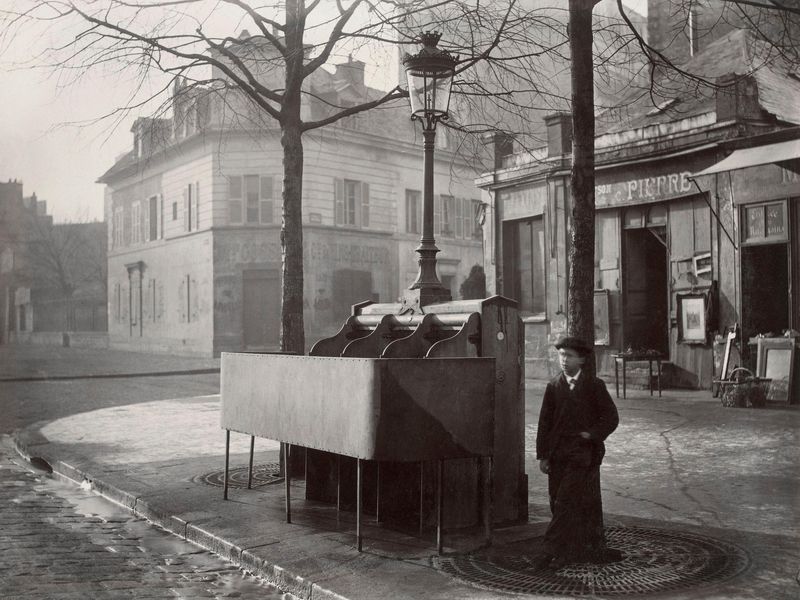
Photograph taken by Charles Marville around 1865, now in the public domain.
Those new avenues were lined with new vespasiennes, which often served added functions of supporting a street light and an illuminated column holding advertising. Below is a photograph taken on boulevard Auguste Blanqui around 1935 by Halasz Gyula.
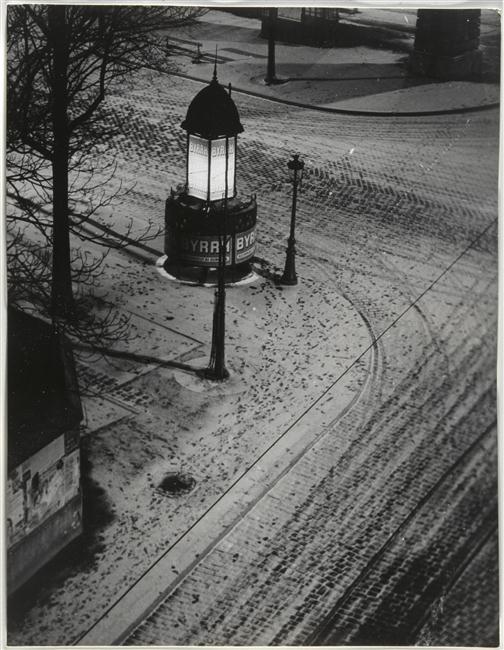
Photograph taken by Halasz Gyula (1899-1984) around 1935.
The köşk of Ottoman garden pavilions, and later the streets of İstanbul, provided the model and the name for the киоск of Russia and the kiosk of France.
The new vespasiennes were built kiosk-style, in cast iron with scale-covered roofs, painted dark green.
A 1937 Gay Men's Guide to London's PissoirsAnd then the vespasiennes became homosexual hotspots. Coded language quickly evolved. To cruise the vespasiennes for gay sex encounters was called prendre le thé or "taking tea", and the urinal itself was a théière or "teapot", or a tasse or "cup". The English called the practice "the tea-room trade" and "cottaging". The term les tasses is still used today in France, and not just within the gay community but by society at large.
There were many indecency arrests in les tasses, many of them based on entrapment. In 1876 the gendarmes found a member of the bourgeoisie engaged in "indecent exposure" with an 18-year-old laborer. The older man was the well-to-do and prominent Catholic politician Eugène de Germiny, who spent his days agitating to get church and state intertwined again, royalty back on the throne, and other conservative hot-button topics. He, of course, claimed that he had been "conducting research". He was sent to jail briefly and then went into exile.

U.S. Republican Senator Larry Craig, arrested for soliciting gay sex in an airport restroom.
The conservative "researcher" became a target of satire, and les tasses remained popular rendezvous points.
Amazon
ASIN: 0202302830
Laud Humphreys' Ph.D. research, which led to his book, showed that many of the men cruising les tasses in the U.S. during his study were politically and socially conservative, and were quite vocal about what he called "the breastplate of righteousness". The more a man had to lose by the exposure of his secret life, the more he worked at the trappings of respectability. "To others in his everyday world, he is not only normal but righteous — an exemplar of good behavior and right thinking."
Humphreys also documented an elaborate multi-stage protocol of visual, physical, and verbal signals back and forth, demonstrating that accidental molestation simply won't happen. Public sex may be a nuisance, but it isn't a danger.
Pissoirs into the 20th Century
Henry Miller wrote of the Paris pissoirs in his Black Spring in 1936:
At the Saint-Cloud bridge I come to a full stop. I am in no hurry — I have the whole day to piss away. I put my bicycle in the rack under the tree and go to the urinal to take a leak. It is all gravy, even the urinal. As I stand there looking up at the house fronts, a demure young woman leans out of a window to watch me. How many times have I stood thus in this smiling, gracious world, the sun splashing over me and the birds twittering crazily, and found a woman looking down at me from an open window, her smile crumbling into soft little bits which the birds gather in their beaks and deposit sometimes at the base of a urinal where the water gurgles melodiously and a man comes along with his fly open and pours the steaming contents of his bladder over the dissolving crumbs. Standing thus, with heart and fly and bladder open, I seem to recall every urinal I ever stepped into — all the most pleasant sensations, all the most luxurious memories, as if my brain were a huge divan smothered with cushions and my life one long snooze on a hot, drowsy afternoon. I do not find it so strange that America placed a urinal in the center of the Paris exhibit at Chicago. I think it belongs there and I think it a tribute which the French should appreciate. ... And yet, how is a Frenchman to know that one of the first things which strikes the eye of the American visitor, which thrills him, warms him to the very gizzard, is this ubiquitous urinal? How is a Frenchman to know that what impresses the American in looking at a pissotière, or a vespasienne, or whatever you choose to call it, is the fact that he is in the midst of a people who admit to the necessity of peeing now and then and who know also that to piss one has to use a pisser, and that if it is not done publicly it will be done privately, and that it is no more incongruous to piss in the street than underground, where some old derelict can watch you to see that you commit no nuisance.
Henry Miller andWilliam S. Burroughs
Codethyline is another name for ethylmorphine, Houdé apparently was a specific brand sold in France at the time.
William S. Burroughs wrote that he first visited Paris at the age of 18, which would have been around 1932. In "Paris Please Stay The Same", written in the 1970s, and collected in The Adding Machine, Burroughs laments changes in Paris including the end of the enormous market of Les Halles, and the decline in the availability of opiates and gay sex in pissoirs. From that 3–4 page essay:
[...]
Some
time ago a friend conveyed to me the melancholy
news that Codethyline Houdé would henceforth
(owing to the Common Market) be dispensed on prescription only.
And I felt the same deep
pang of loss as I experienced when they ripped the urinals
from the streets, tore down Les Halles, and cut down the
trees in the Grand Socco of Tangier and changed the
spelling to Tanger.
'Tis gone, 'tis gone...another corner of the
19th century...brightness falls from the air...the urinals,
Les Halles, the trees...
"Codethyline
Houdé..."
"Oui
Monsieur...une ou deux?"
"Deux."
I'll remember her that way.
"The
things we have never remain.
It is the things we have that go..."
[...]
Pharmacie...green
neon letters in electric blue
twilight...washed down twenty-four pinkies with a
café crême, then it hit the back of
my neck and crept down the backs of my thighs
and there was this Edith Piaf number
on the jukebox...
[...]
And
I remember Les Halles, not as I saw it in the Fifties
and Sixties, but as I saw it on my first solo trip to
Europe at age eighteen after a night of drinking...onion
soup, smell of sawdust, red wine, urine and bread...The
cab driver who parked his cab and asked me into a bar
for a drink.
He was talking about the Stravinsky riots:
"Et tout d'un coup...Bthruuuuuuup" (a sound
like ripping cloth).
When you hear machine guns you know it's serious...(knowing
laugh of the dead).
[...]
It
is fall and there are dead leaves in the
street...somewhere around Auteui...a long wall...
"Simon,
aimes-tu le bruit des pas sur les feuilles mortes?"
Simon, do you like the sound of footsteps on dead leaves?
Dead leaves drifting into the pissoir, sharp ammonia
reek of urine...there on the galvanized iron, words
that could have been written by Rimbaud:
"J'aime ces types vicieux, q'ici montrent la
bite"—I like the vicious types
who show their cocks here...Un soldat jeune,
très jeune,
glances sideways...Oh la la...Well 'tis gone 'tis gone...
[...]
It
is the things we have that
go...the urinals...Les Halles...the
trees...Tangier...Codethyline Houdé...
[...]
Pissoirs Against the Nazis
WWII FrenchResistance
Germany occupied Paris from 14 June 1940 until 23 August 1944. La Résistance or the French Resistance fought an underground war against the occupiers.
Within Paris, Résistance members found the vespasiennes to be useful rendezvous points for passing messages and transferring supplies and weapons. A new multi-step defensive protocol was needed, in order to make Résistance meetings safe despite German surveillance.
Musée du Général Leclerc de Hauteclocque et de la Libération de Paris — Musée Jean MoulinA new museum on the Résistance, the Résistance leader Jean Moulin, and the military leader Philippe de Hautecloque, who operated under the nom de guerre Philippe Leclerc, opened in 2019. It's coincidentally just a few blocks away from the last vespasienne in Paris.
The museum was built in a structure formerly used for testing road construction materials. The site was chosen because an air raid shelter far below street level became a base for the Résistance during the final liberation of Paris.
The museum is very nicely done, carefully presenting a wide range of information to the visitor. Then, if you're careful to register in advance for the limited access, you can descend some 100 or more steps down into the bunker space. Among many other features, it includes the toilets used by the Résistance during the Libration of Paris.
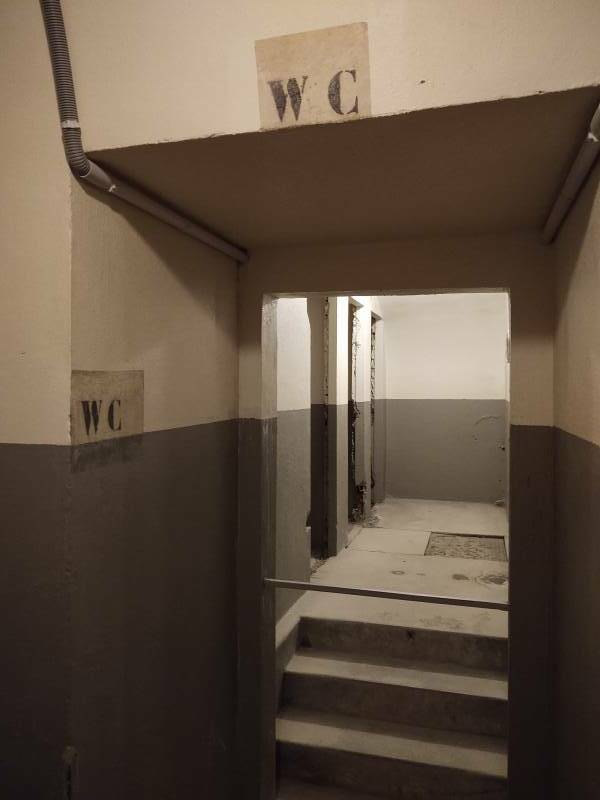
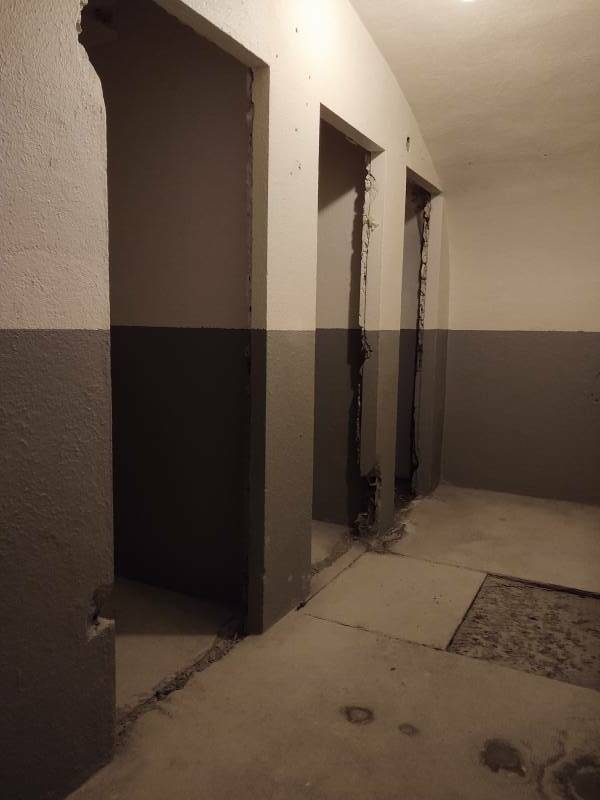
Vespasiennes Fade Away in Paris
In the 1930s the pissoir inventory in Paris hit its peak of 1,230. But worries about their use for gay sex led the authorities to start dismantling some. In late 1959 the Conseil de Paris was controlled by right-wing politicians, and it voted to remove all of them.
Complete removal of the pissoirs would obviously lead to vast increases in public urination. Public outcry led to the repeal of the right-wing pissoir total ban in early 1961. However, the number continued to decline.
2005 French article on the end of les tassesBy 1966 the number of pissoirs had dropped from their 1930s peak to 329. And, all along, while there had been attempts through the years to construct chalets de nécessité and lavatoires souterraines for the ladies, there were only a few, and the city was adding none.
In 1979 Jacques Chirac was elected as Mayor of Paris. In 1981 his administration voted to replace all vespasiennes in Paris with the new Sanisettes, automated unisex modules that automatically washed themselves after each use. And, which you had to pay to use.
By 2020 only one early 20th century vespasienne remained in all of Paris. It was on Boulevard Arago beside the Centre Pénitentiare de Paris la Santé. Yes, the prison of Paris, Jean Valjean and Javert and all that. But as you can see in the below map, the French Astrophysics Institute, the Protestant Theological Institute, and other relatively high-brow establishments are also within a block or two along Boulevard Arago. And, Gare Montparnasse and the Résistance museum are just another two blocks to the west.
In April 2022 I was able to visit the last vespasienne, photograph it, and — as we see from the blue border — use it.
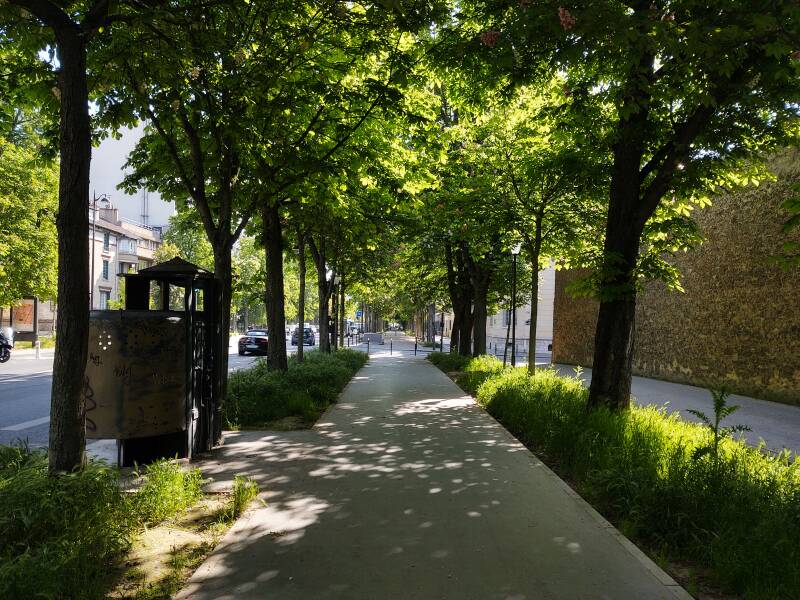
As I was taking this first picture, a man jogging down the sidewalk stopped and told me:
Monsieur, c'est un des derniers à Paris.
[ Sir, that is one of the last in Paris. ]
I was able to respond authoritatively, having looked into this:
Non, monsieur, c'est LA dernier
de tout Paris.
[ No, sir, that is THE last one
in all of Paris. ]
I think he was mildly impressed.
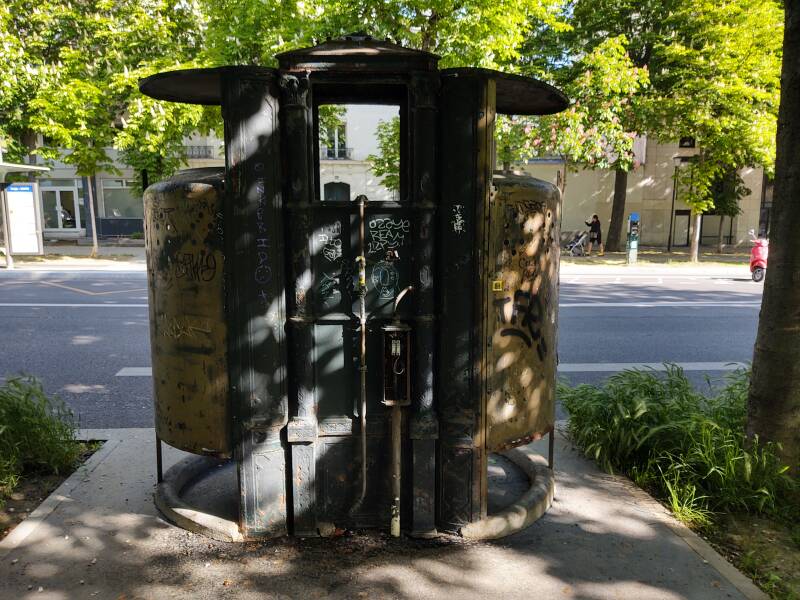
Here are two views from the sidewalk side.
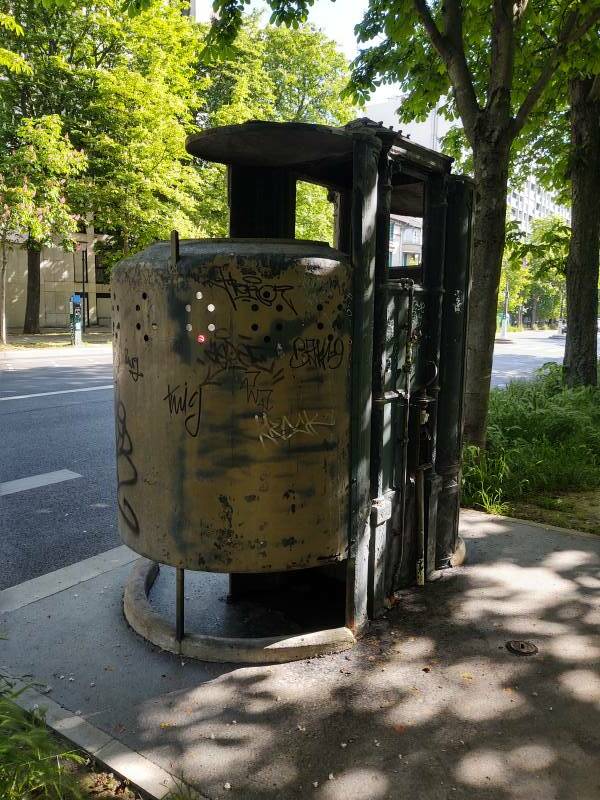
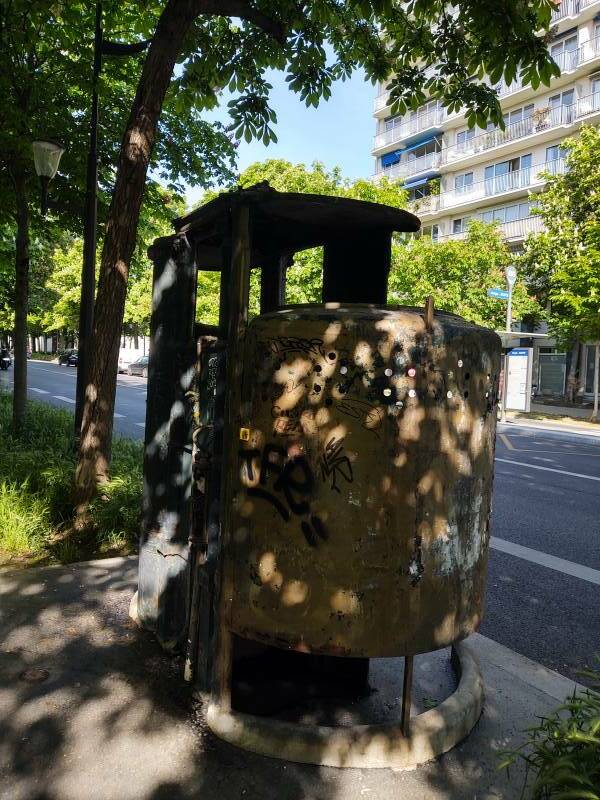
Amazon
ASIN: B004GGQN1E
Amazon
ASIN: B000W11NQ2
It is tagged erroneously in Google Maps as "The last public urinal in Paris." As you will see in the following section of this page, many public urinals remain in Paris and more are added all the time. But this one is the last vespasienne, the very last of the late 1800s design urinals.
And now, carefully checking the traffic before stepping into the street to capture the entry side:
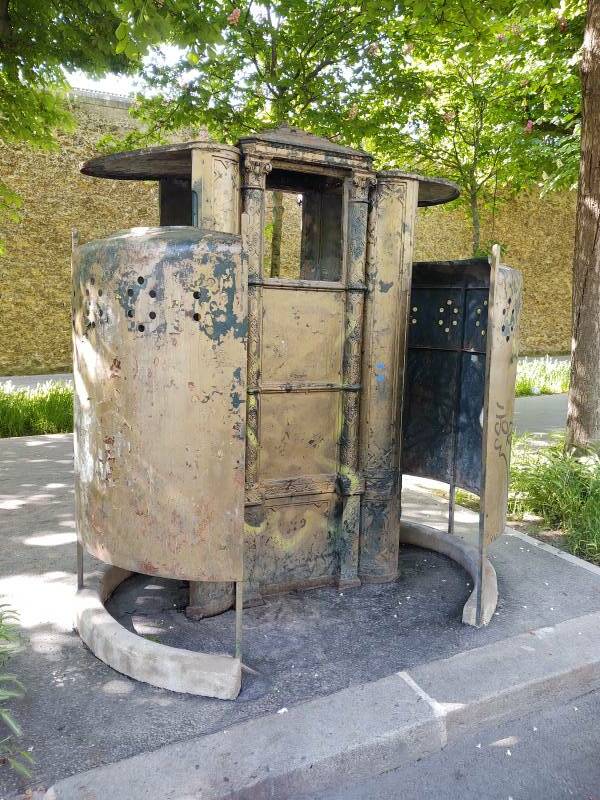
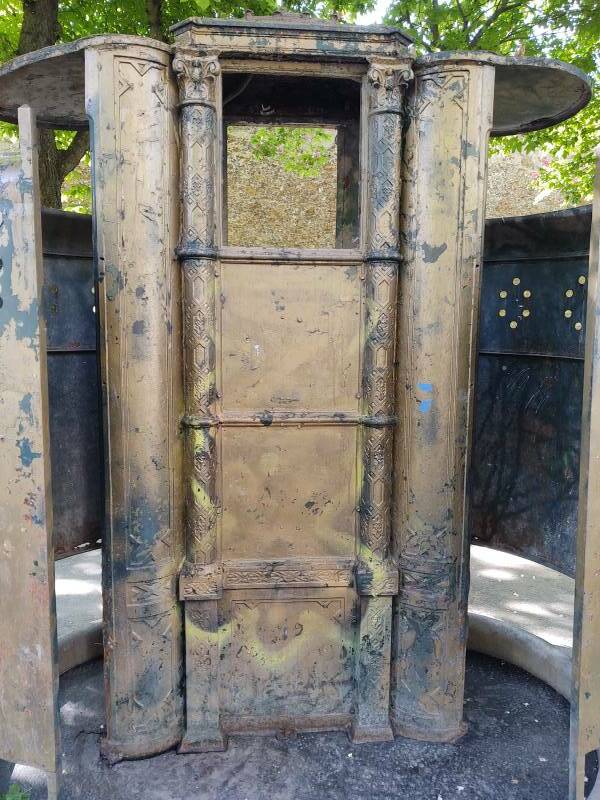
As you step in you see that you're shielded from your face down to mid-shin.
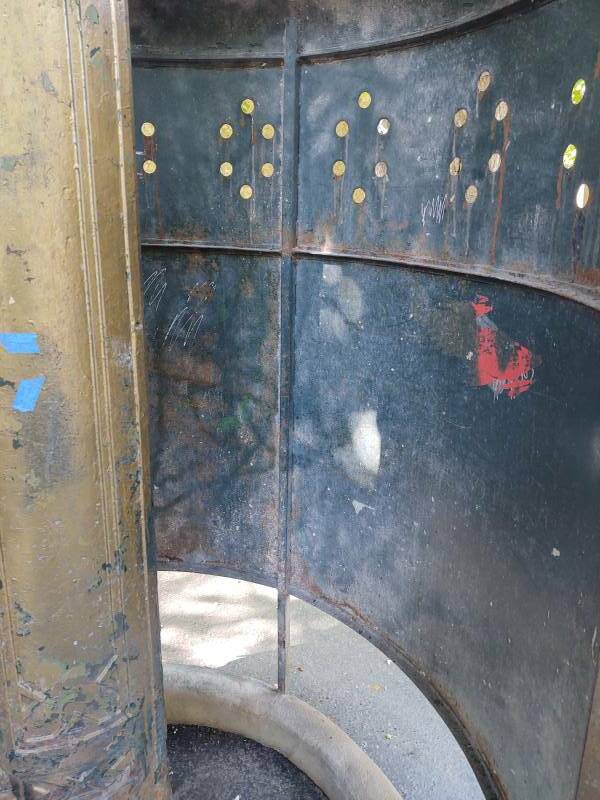
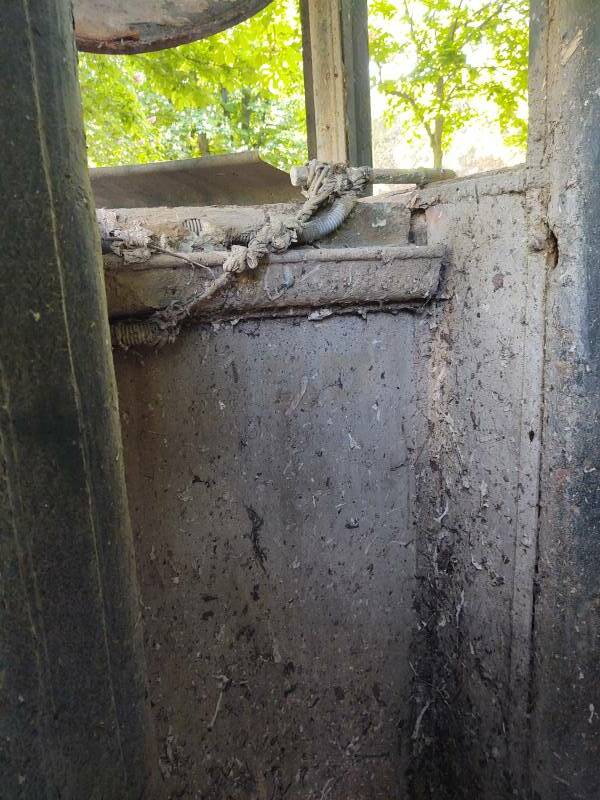
It doesn't seem to be plumbed into any drain, which probably is much like the original. It probably doesn't get a huge amount of use today, so what is collected can largely absorb into the ground between the street and the broad sidewalk. I certainly caused no flood.
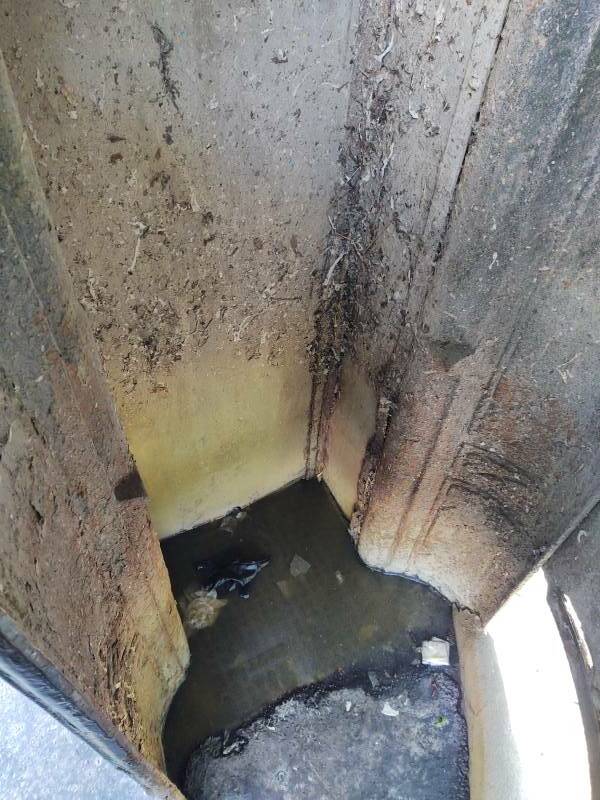
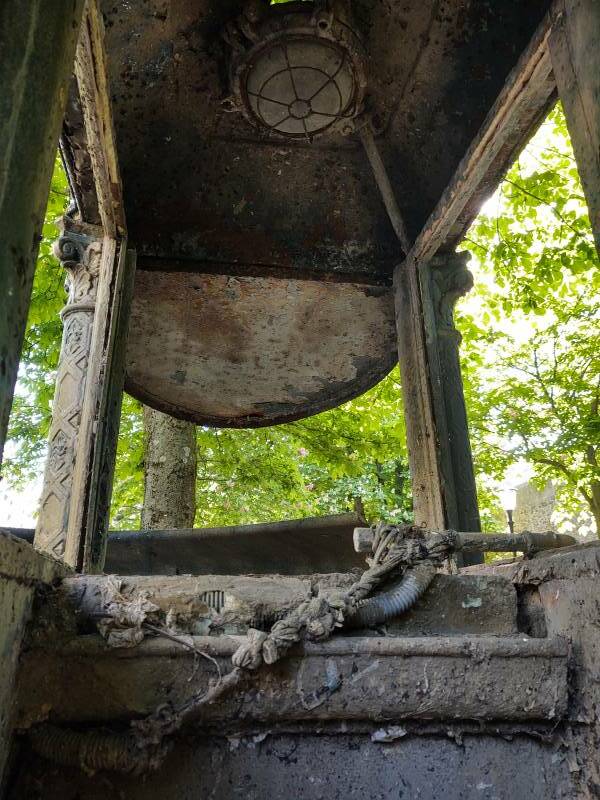
You can see that there was plenty of space for the Résistance to hide messages in the vespasiennes, and even meet to hand over small packages of supplies and weapons.
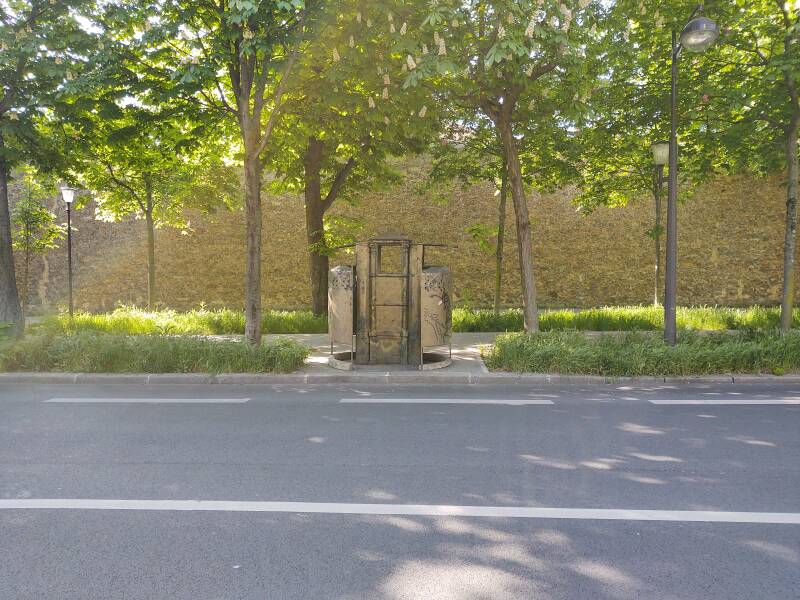
Paris Pissoirs Today
CanalSaint-Martin
The vespasiennes are almost gone, but pissoirs remain in Paris and across France.
Here is a portable pissoir along the Canal Saint-Martin in Paris, in the 10th arrondissement near Gare de l'Est.
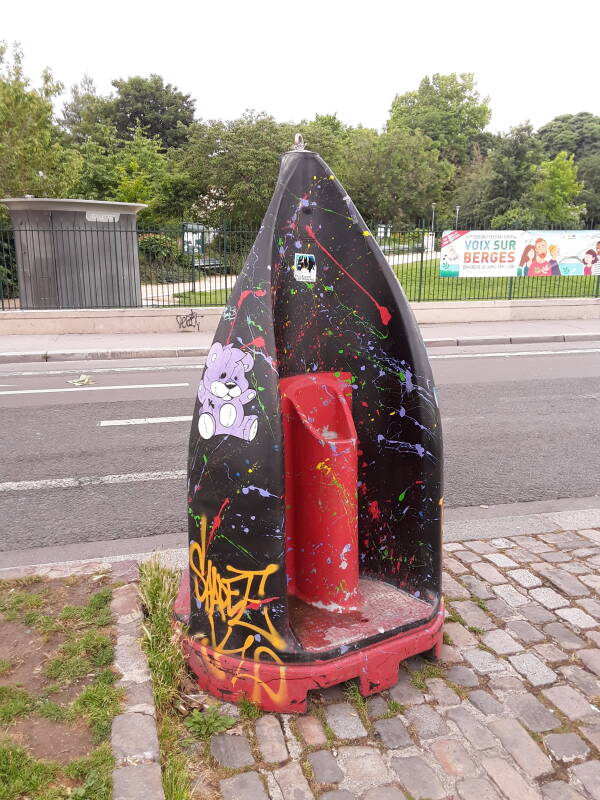
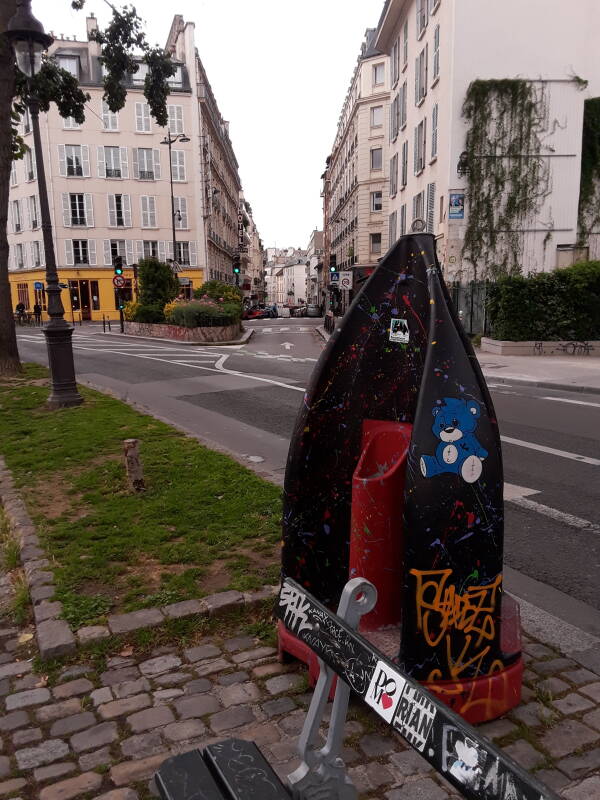
A little further southeast along the Quai de Valny along Canal Saint-Martin we come to this steel pissoir. This design is much more comfortable to use than the portable one, but you're still rather exposed.
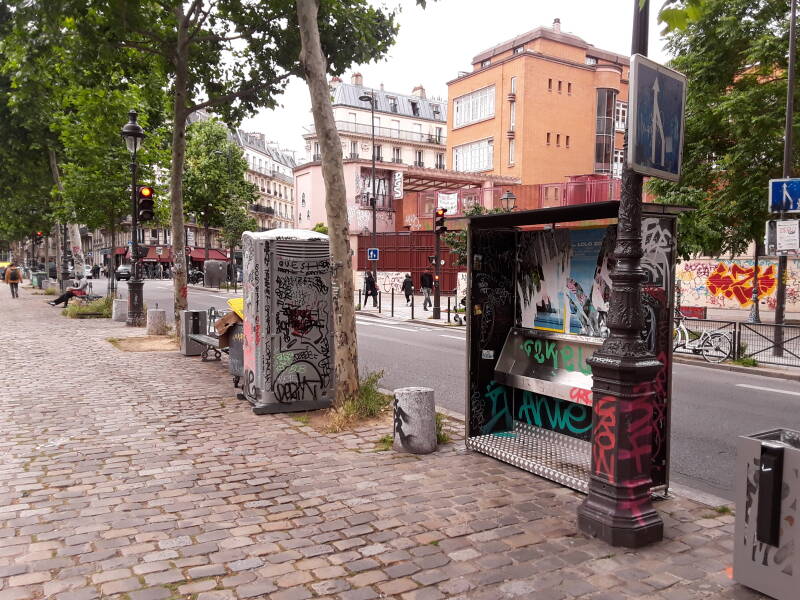
The exposure is, of course, intentional. There's no enclosed space for illicit activity. Do your business and move along.
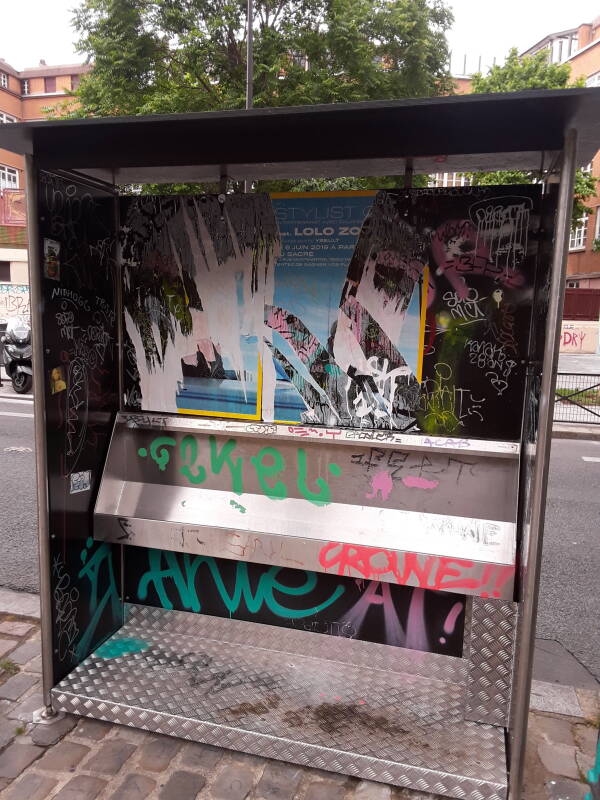
A Sanisette is nearby for the ladies, and for men who want privacy.
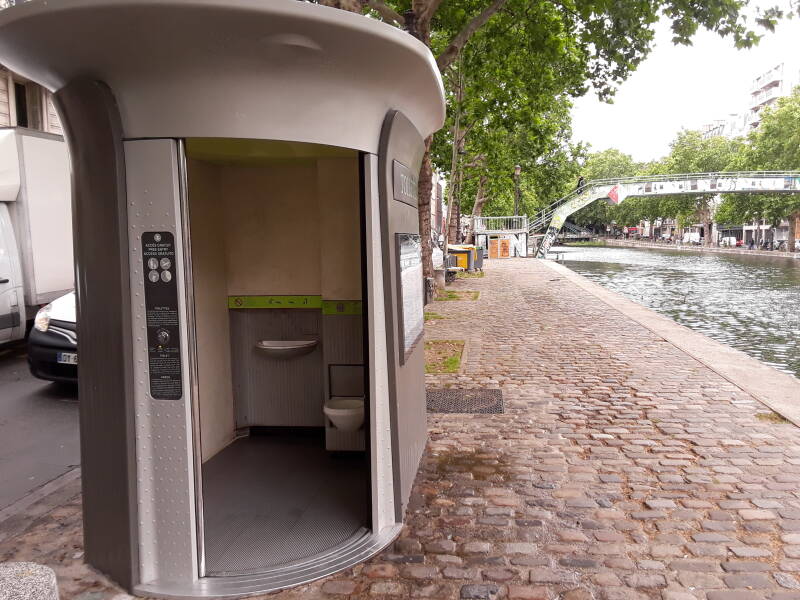
Saint-Denis
Here is a new design, a metallurgically modern vespasienne in stainless steel rather than the traditional green painted steel. This is in Saint-Denis, a northern suburb of Paris, home of the cathedral church where most of French royalty is buried.
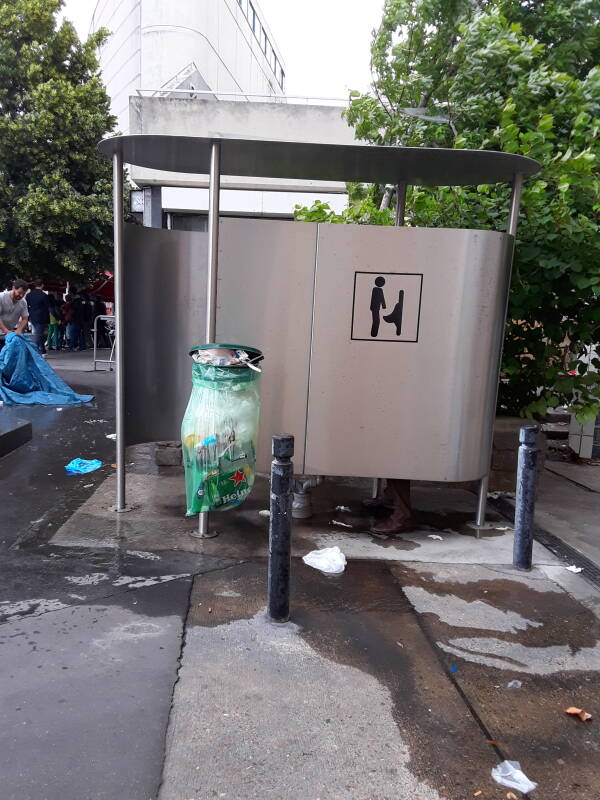
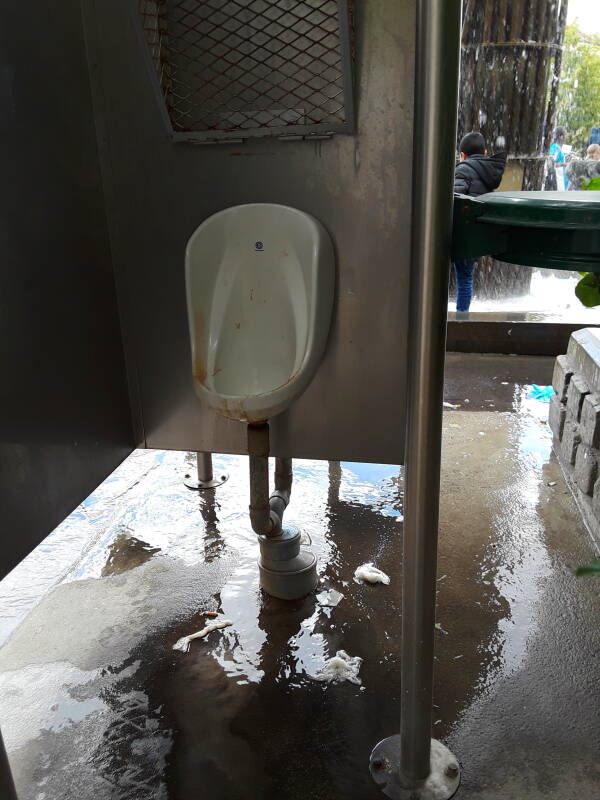
Pissoirs Across France
VisitingArles
Arles
The amphitheater in Arles was built in 90 CE. It's large, 136 meters long and 109 meters wide, with two levels around its exterior, each with 120 arches. It could seat up to 20,000 for entertainment spectacles including chariot races and gladiatorial combat. Today it has a minimal-privacy pissoir.
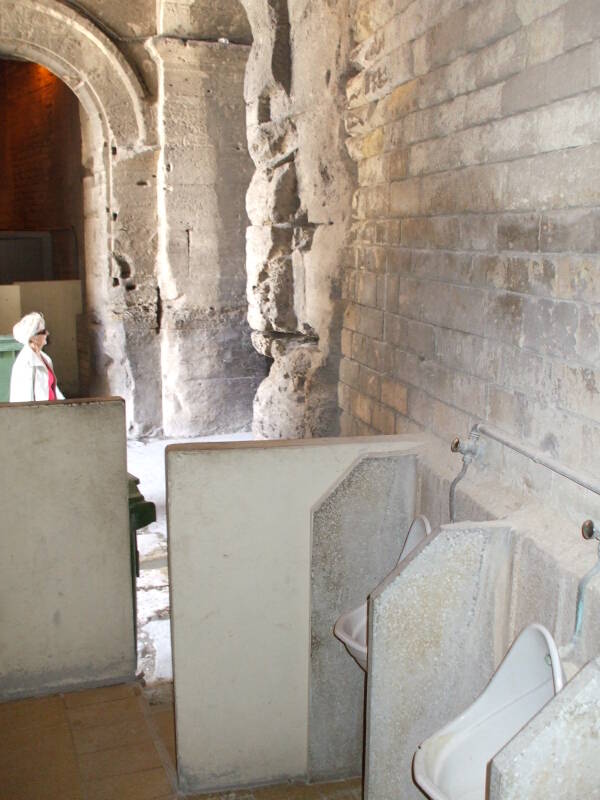
Arromanches-les-Bain
VisitingArromanches-les-Bain
Arromanches-les-Bain is in the Calvados départment of Normandy. A Mulberry artificial harbor was assembled here during the Invasion of Normandy, immediately after D-Day. It allowed unloading supplies and heavy equipment before deep water ports had been captured.
This pissoir provides a moderate level of privacy from outside, but two users would rub shoulders.
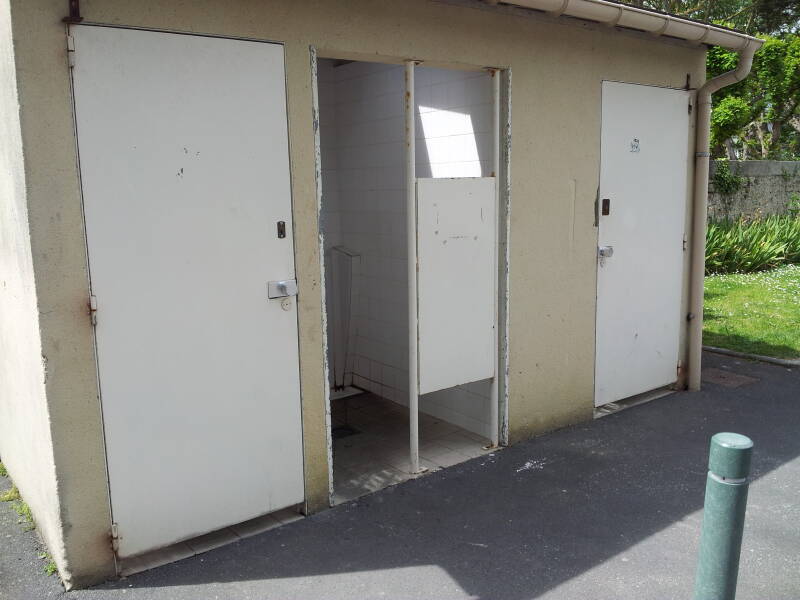
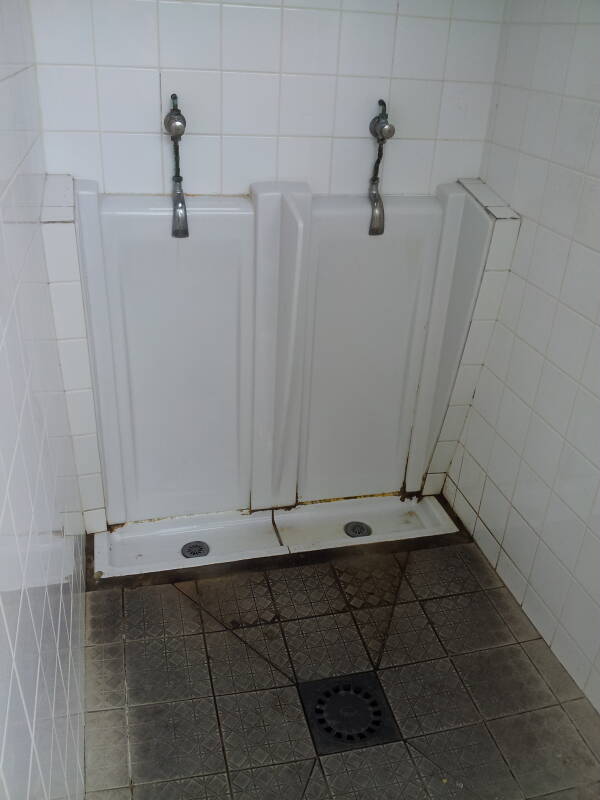
Briare
Canal Latéralà la Loire
Here we're in Briare, ready to start a boat trip along the Canal Latéral à la Loire through the Burgundy region. This bridge crosses a connection between the Briare Canal and the Canal Latéral à la Loire. The town has built a pissoir at one end of the canal, draining directly into the canal.
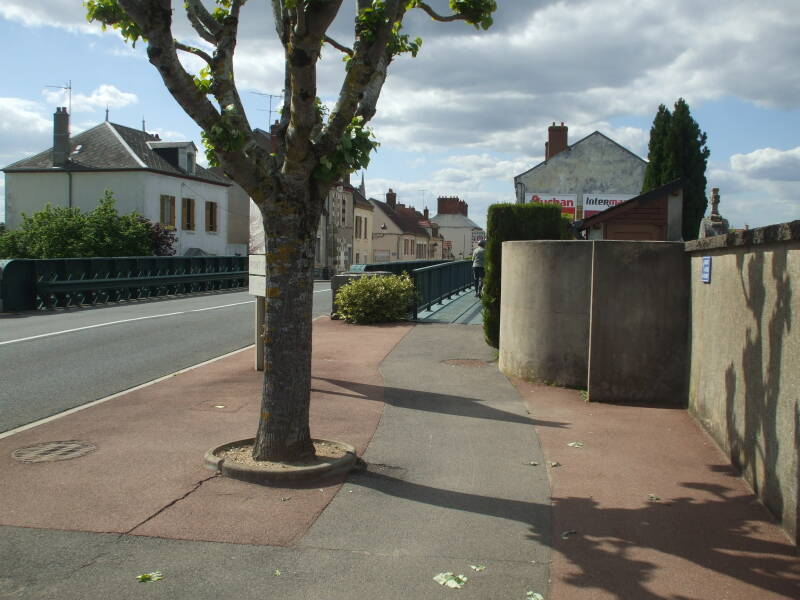
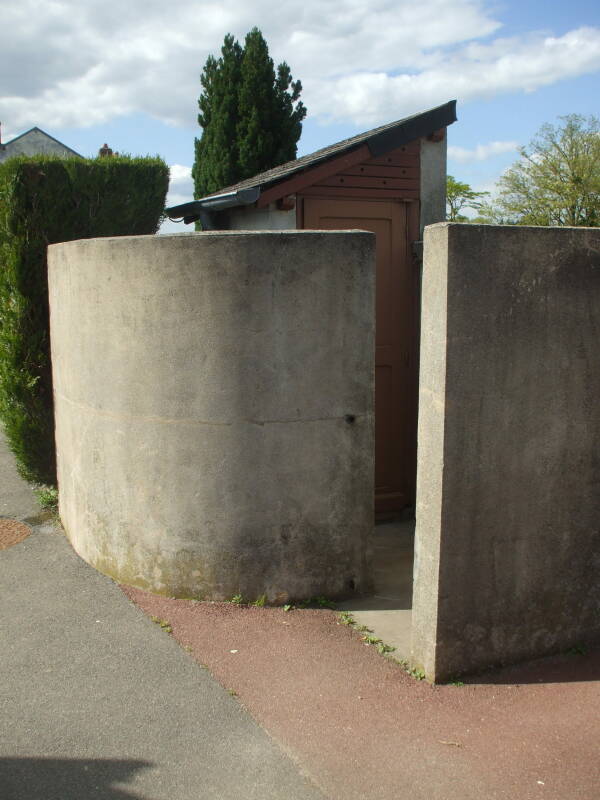
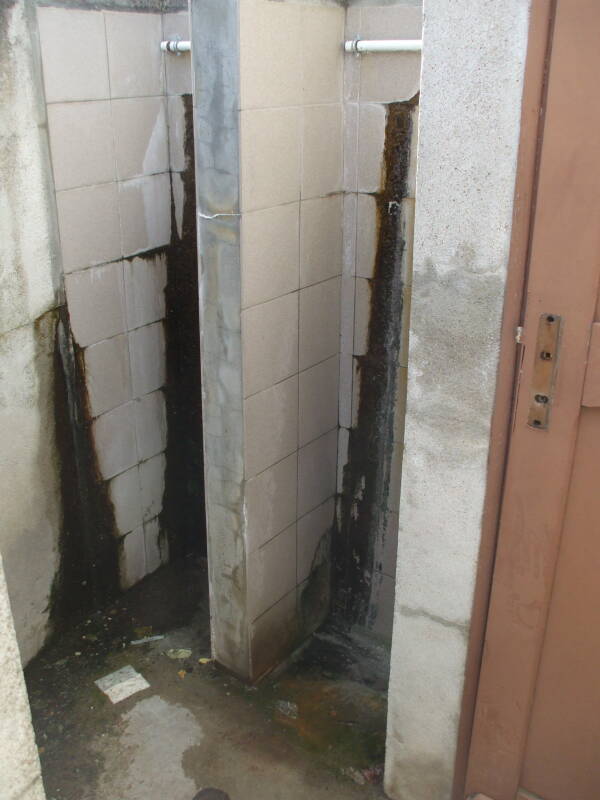
The facility also includes a squat toilet, which is plumbed into the town's sewage system.
Exactement! Urine in the canal is fine. Feces would cause health problems.
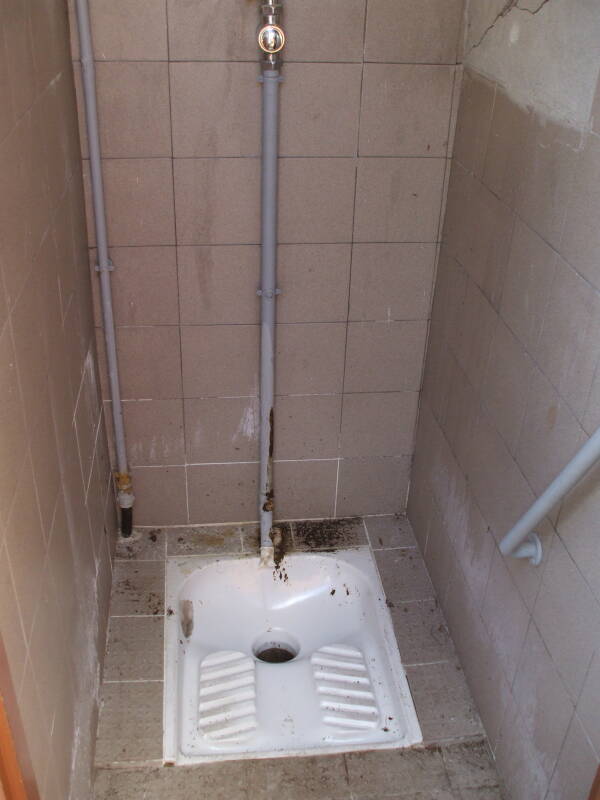
Recent Developments in French Pissoirs
Paris recently experimented with the uritrottoir, a simple and extremely public urinal. They're sort of like peeing into a bright red mailbox that has a flower box on top.
They were extremely unpopular with many people. Of course they're for men only, encouraging men to relieve themselves in extremely public ways. Protests led to intentional damage to the new facilities.
A reporter from BBC 5 interviewed me for their story about the uritrottoir.
Madame PeeThe latest development is women's urinals deployed by Madame Pee, a recent start-up.
Pissoirs Outside France
France has no monopoly on extremely public urinals.
Belgian Pissoirs
Here is a row of four urinals against the wall of the Brussels cathedral of Saint Catherine.
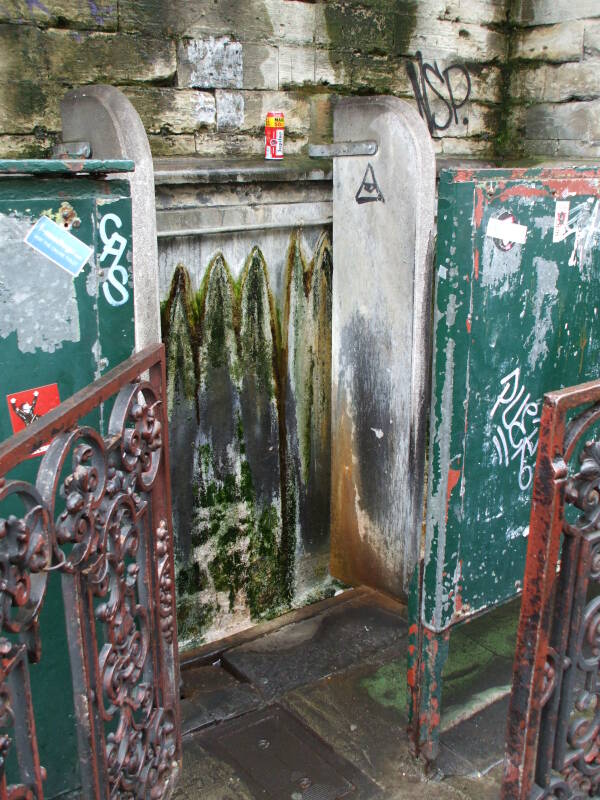
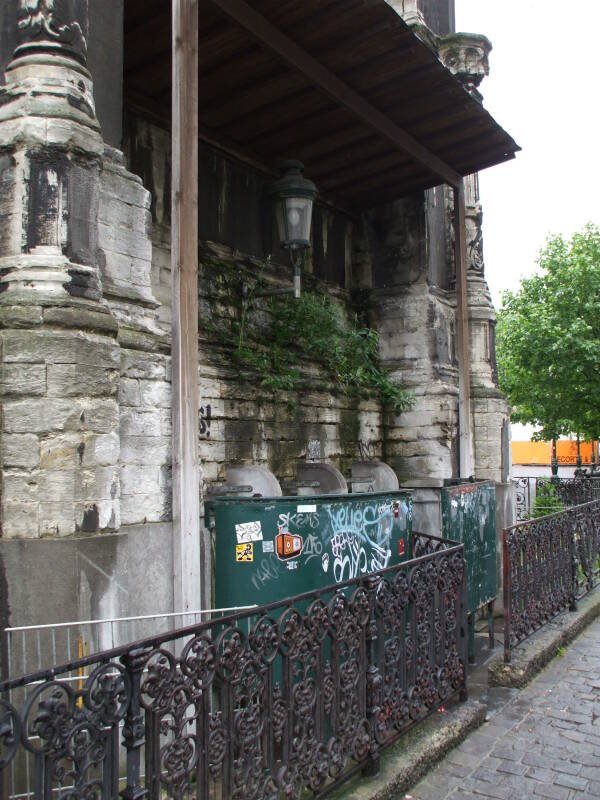
Both French and Flemish, a form of Dutch, are spoken in Belgium. Brussels is close to the gradual language boundary. You encounter more French than Flemish in Brussels, although as the capital both are used equally on signs.
In French this would be a pissoir against the side of Église Sainte-Catherine de Bruxelles. In Flemish, they use the French word pissoir, but call the church Kathedraal Sint-Katelijne.
The cathedral was built in 1854-1874, replacing a 15th century structure. As you can see, the pissoir is just around the corner from the façade.
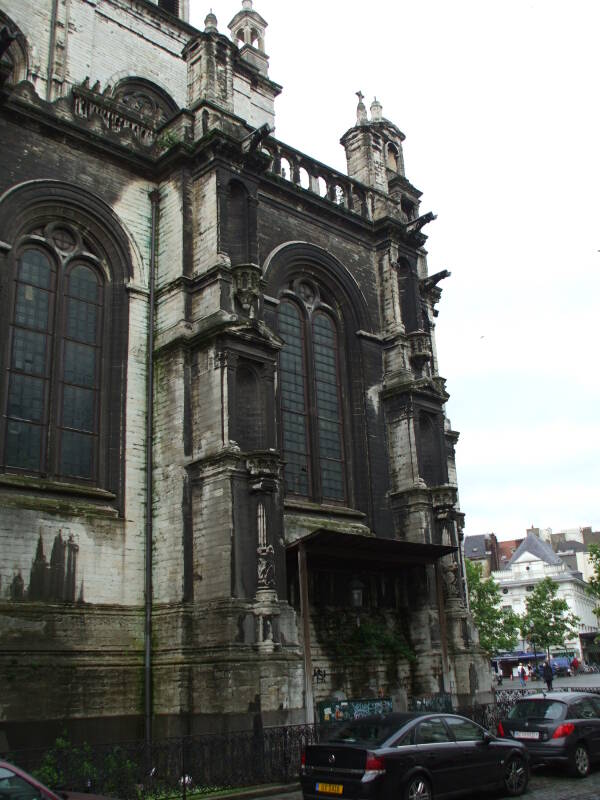
Dutch Pissoirs
Central Amsterdam has about 35 vintage plaskruls, Dutch for "pee curls". Their design dates to the end of the 19th century.
The pee curl is made from a steel sheet, formed into a spiral shape with a vertical axis, painted dark green and held a half-meter above the ground by four steel legs.
Twenty years after Rambuteau's introduction of urinary columns in Paris, the Dutch inventor Leijs proposed similar hollow cylinders in Amsterdam.
However, the city did not act on that suggestion. They selected the pee curl design, in order to make it easy for the police to spot abuse of the facilities for homosexual activity. The first pee curls were installed around 1870. In 1877 they installed the first double pee curl, an S shape with two opposing chambers.
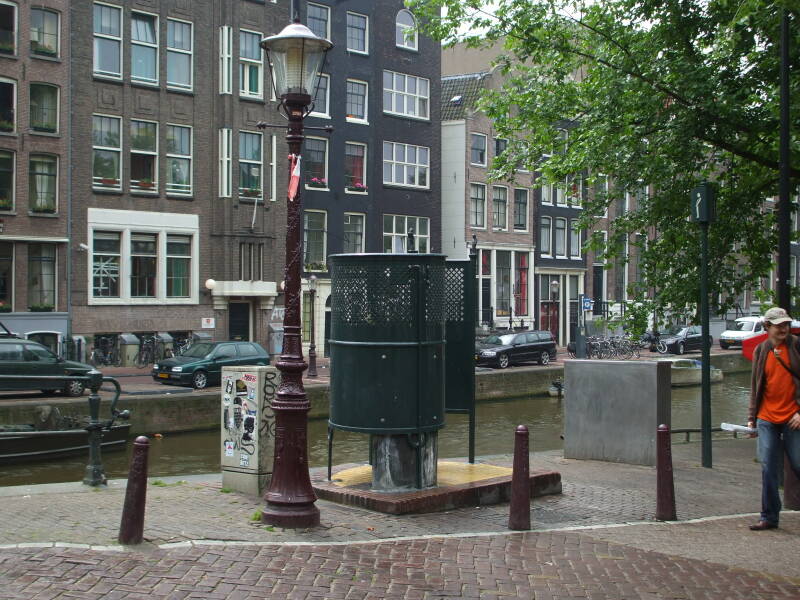
The top half of the sheet is perforated so you can see through it at eye level. The pee curl contains a vertical slab of rough natural stone, as if this were some mysterious Dutch shrine to a urine deity. Its tile floor has a central drain connected to the city's sewer system.
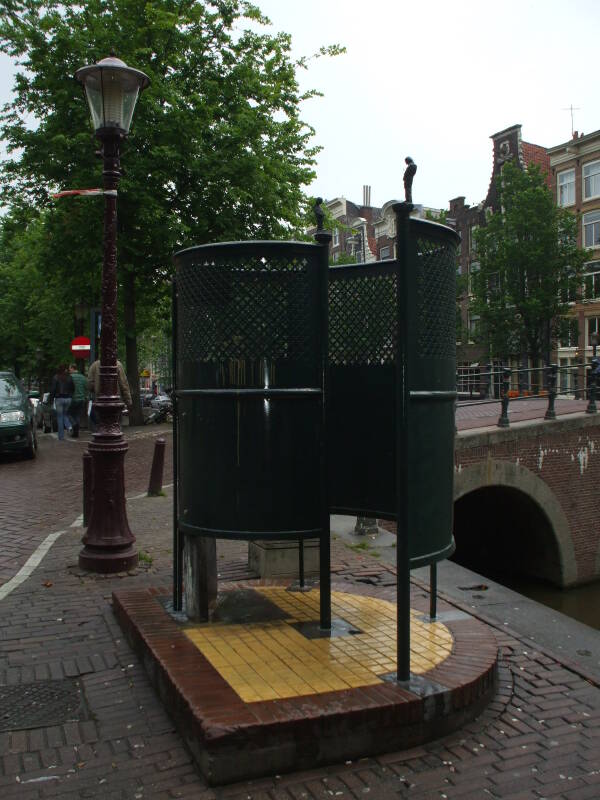
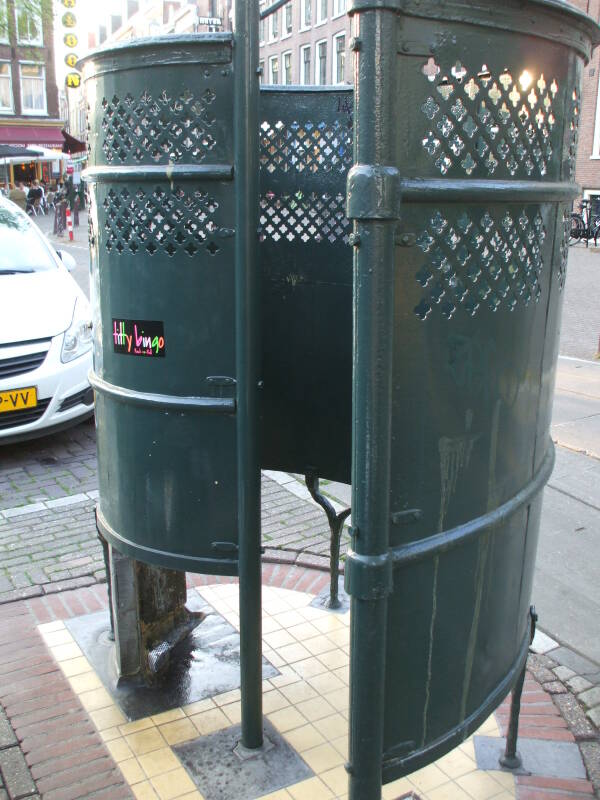
Amsterdam restored, galvanized, and repainted all of its pee curls in 2008. In 2017, there were thirty-five vintage pee curls still in operation.
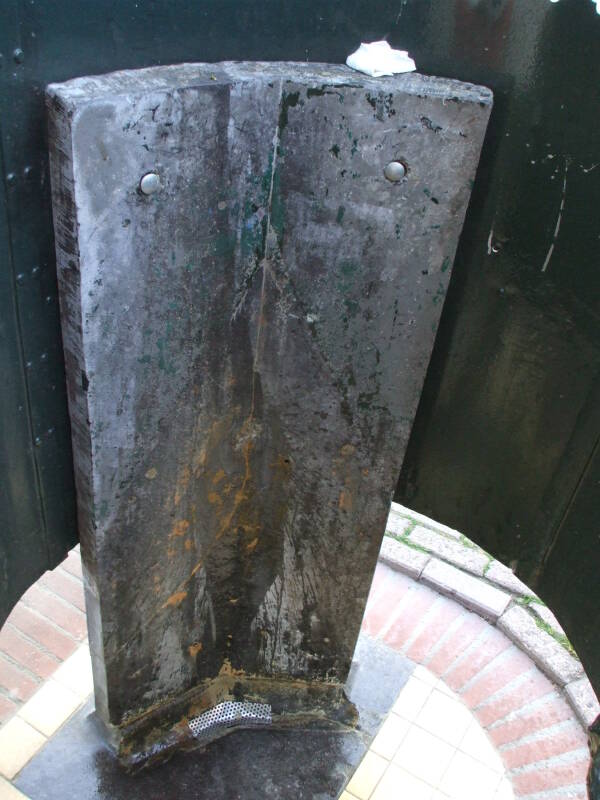
Amsterdam also has portable highly public urinals, which they can easily move around for outdoor concerts and other events.
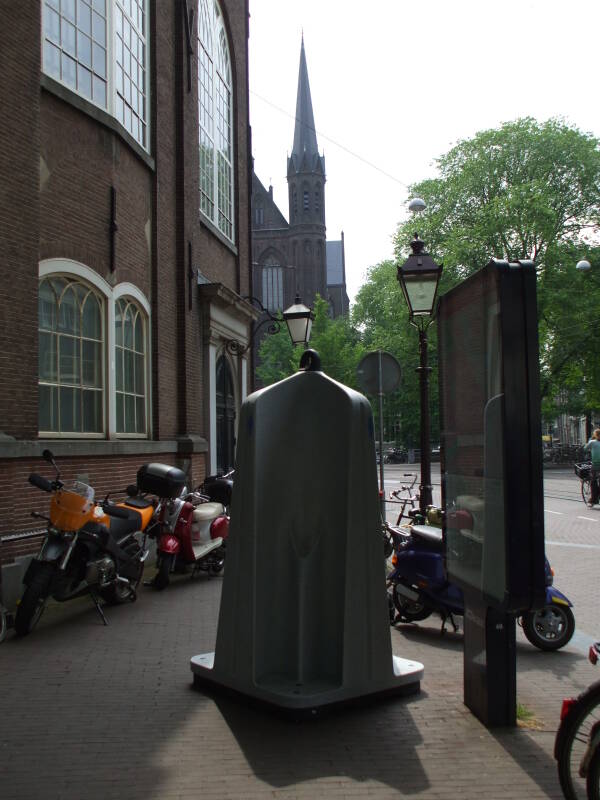
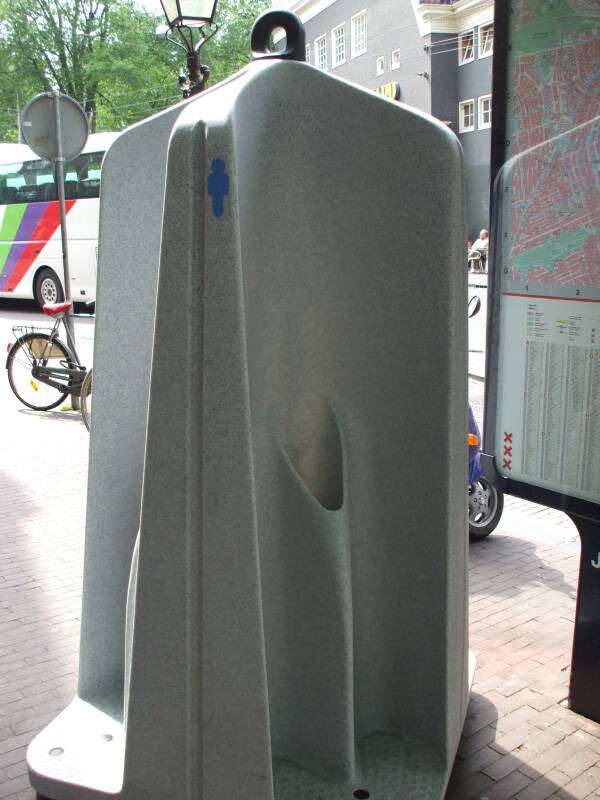
They are, of course, men-only devices. Amsterdam is surprisingly behind the trend toward sexual equality, at least as far as urinals go. In 2017 Amsterdam had only three public toilets suitable for women, while Berlin had 177. Paris had 150, and that was before Madame Pee began operation.
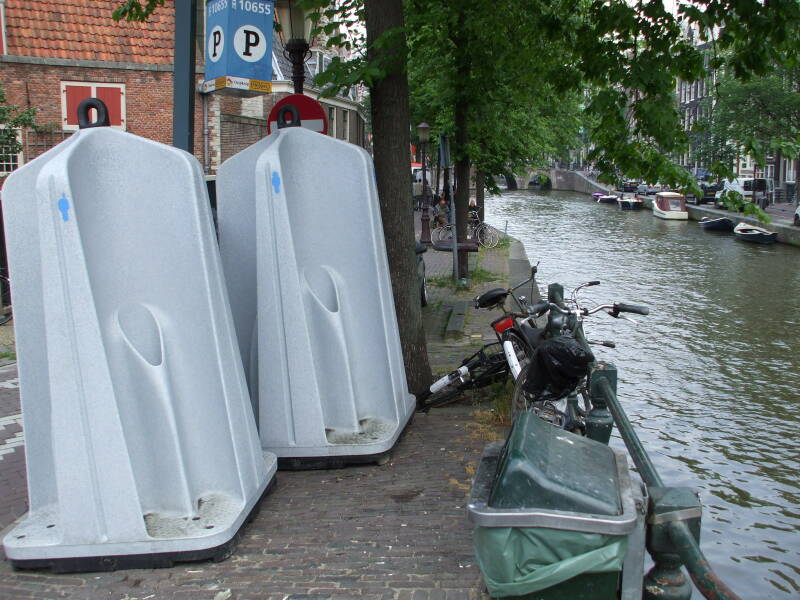
Japanese Pissoirs
Visiting NaoshimaThe public restrooms near the harbor on the Japanese island of Naoshima in the Inland Sea have very limited privacy.
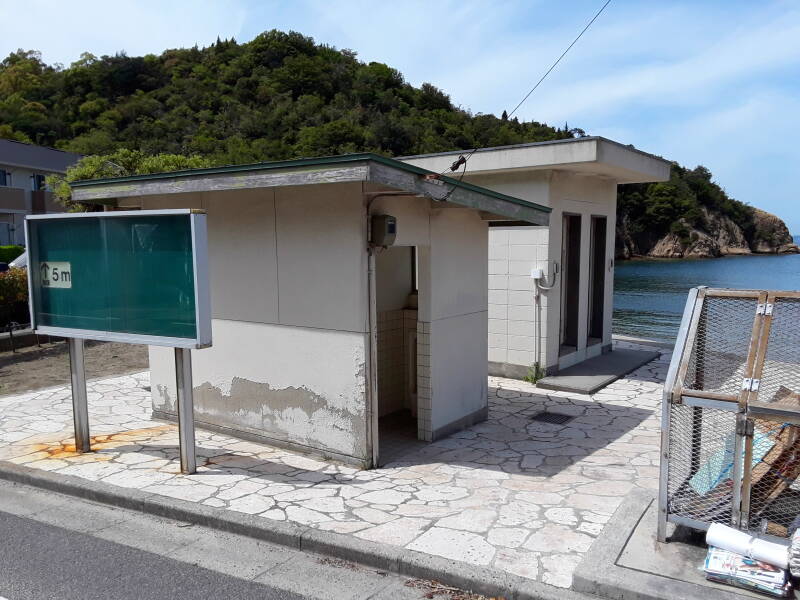
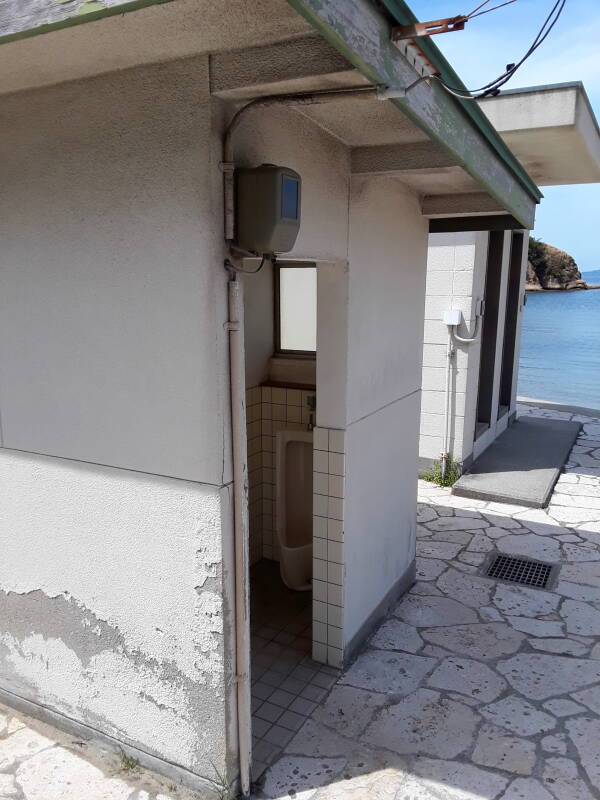
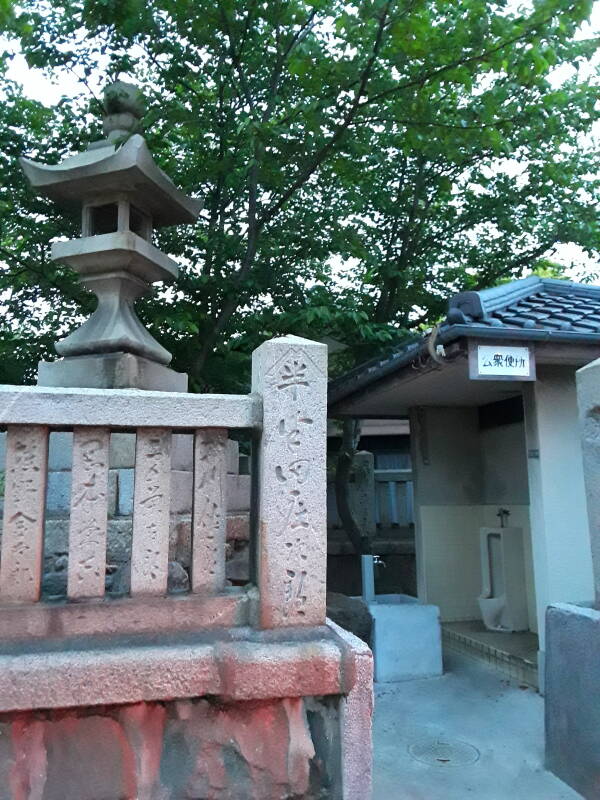
This urinal at a small Buddhist temple complex in Kyōto has very little privacy.
